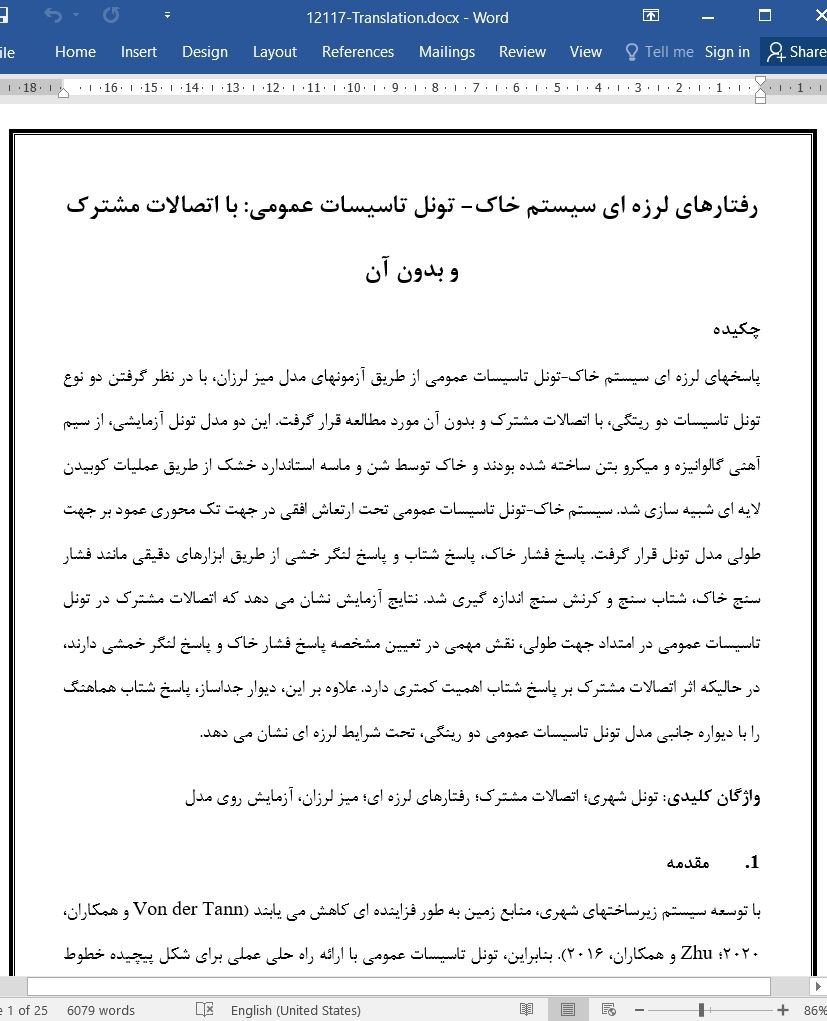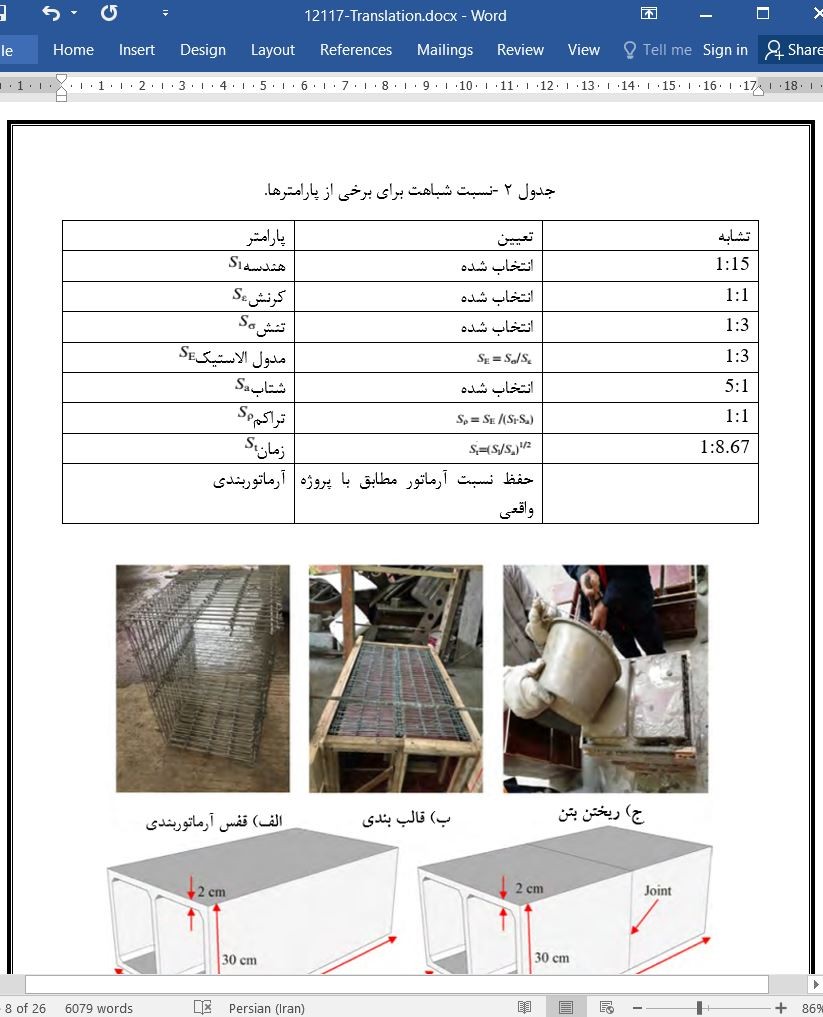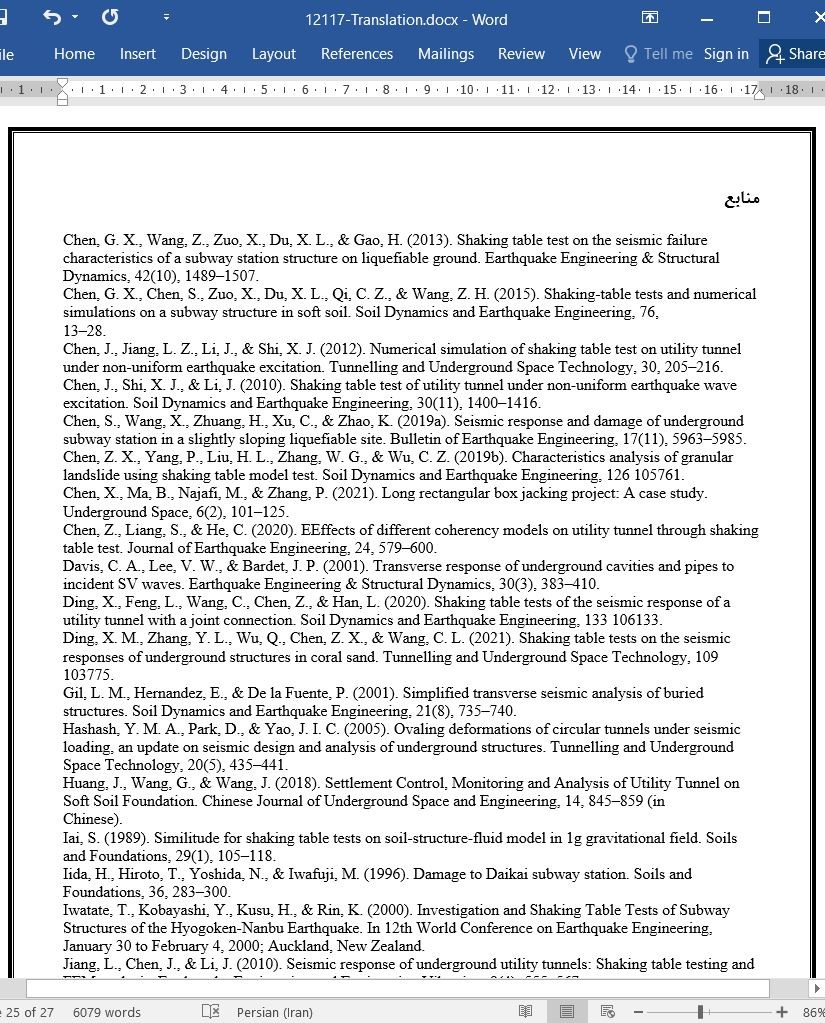
رفتارهای لرزه ای سیستم خاک- تونل تاسیسات عمومی: با اتصالات مشترک و بدون آن
چکیده
پاسخهای لرزه ای سیستم خاک-تونل تاسیسات عمومی از طریق آزمونهای مدل میز لرزان، با در نظر گرفتن دو نوع تونل تاسیسات دو ریتگی، با اتصالات مشترک و بدون آن مورد مطالعه قرار گرفت. این دو مدل تونل آزمایشی، از سیم آهنی گالوانیزه و میکرو بتن ساخته شده بودند و خاک توسط شن و ماسه استاندارد خشک از طریق عملیات کوبیدن لایه ای شبیه سازی شد. سیستم خاک-تونل تاسیسات عمومی تحت ارتعاش افقی در جهت تک محوری عمود بر جهت طولی مدل تونل قرار گرفت. پاسخ فشار خاک، پاسخ شتاب و پاسخ لنگر خشی از طریق ابزارهای دقیقی مانند فشار سنج خاک، شتاب سنج و کرنش سنج اندازه گیری شد. نتایج آزمایش نشان می دهد که اتصالات مشترک در تونل تاسیسات عمومی در امتداد جهت طولی، نقش مهمی در تعیین مشخصه پاسخ فشار خاک و پاسخ لنگر خمشی دارند، در حالیکه اثر اتصالات مشترک بر پاسخ شتاب اهمیت کمتری دارد. علاوه بر این، دیوار جداساز، پاسخ شتاب هماهنگ را با دیواره جانبی مدل تونل تاسیسات عمومی دو رینگی، تحت شرایط لرزه ای نشان می دهد.
1. مقدمه
با توسعه سیستم زیرساختهای شهری، منابع زمین به طور فزاینده ای کاهش می یابند (Von der Tann و همکاران، 2020؛ Zhu و همکاران، 2016). بنابراین، تونل تاسیسات عمومی با ارائه راه حلی عملی برای شکل پیچیده خطوط لوله زیرزمینی، به تدریج در طی شهرنشینی به منظور استفاده کامل از فضای زیرزمینی مورد پذیرش قرار می گیرد (Wang و همکاران، 2018b، Yang و همکاران، 2019a، Chen و همکاران، 2021) و از مراکز تاریخی محافظت می کند (Valdenebro & Gimena، 2018). از یک سو، بسیاری از خطوط لوله زیرزمینی (مانند کابلهای ولتاژ بالا، لوله آبرسانی، لوله حرارتی، کابل مخابراتی و خط لوله گاز) را می توان مستقیماً در آن نصب کرد تا کارگران بتوانند به راحتی این خطوط لوله مهم را حفظ و نگهداری کنند. از سوی دیگر، هنگامی که تونل برق به طور مداوم در طی خطرات طبیعی یا سایر شرایط اضطراری آسیب شدیدی را متحمل شود، شکست این خطوط لوله زیرزمینی، قربانیان زلزله را مضطرب تر می کند (Sakai و همکاران، 2017). اخیراً مطالعات مختلفی در رابطه با تونل زیرزمینی تاسیسات از منظر فن اوری ساخت و ساز (Valdenebro و همکاران، 2019)، اثر عمق دفن (Xu و همکاران، 2018)، تاثیر تونل تاسیسات عمومی بر ساختمان های مجاور (Tan و همکاران، 2019) کنترل و نظارت بر شهرک سازی (Huang و همکاران، 2018 و طراحی اقتصادی (Li و همکاران، 2019) انجام شده است که اکثر آنها در شرایط ایستا بودند. با این حال، از آنجایی که زلزله یکی از جدی ترین مخاطرات طبیعی است، عملکرد لرزه ای را نباید نادیده گرفت (Chen و همکاران، 2019b).
Abstract
Seismic responses of utility tunnel-soil system were studied via shaking table model tests with considerations of two kinds of double box utility tunnels: with and without joint connections. These two testing utility tunnel models were made of galvanized iron wire and micro-concrete, and the ground was simulated by the dry standard sand through layered tamping treatment. The utility tunnel-soil system was subjected to horizontal vibration in uniaxial direction perpendicular to the longitudinal direction of tunnel model. Via instrumentations of earth pressure gauges, accelerometers and strain gauges, the earth pressure response, acceleration response and bending moment response were measured. The testing results show that the joint connections in the utility tunnel along the longitudinal direction play an important role in determining the characteristic of earth pressure response and bending moment response, whereas the effect of joint connections on acceleration response is less significant. In addition, the partition wall exhibits the consistent acceleration response with the side-wall of double box utility tunnel model under seismic condition. Based on the testing results, it is suggested that the joint connection should be taken reasonably into consideration during design and construction for engineering practice.
1 Introduction
With development of city infrastructure system, land resources are becoming increasingly scarce (Von der Tann et al., 2020; Zhu et al., 2016). Therefore, the utility tunnel is gradually adopted during urbanization to fully utilize the underground space (Wang et al., 2018b; Yang et al., 2019a; Chen et al., 2021) and protect the historic centers (Valdenebro & Gimena 2018), as it provides a practical solution to the complex layout of underground pipelines. On the one hand, many underground pipelines (like highvoltage cables, water supply pipe, heat pipe, telecommunications cable, and gas pipeline) can be installed in it directly so that workers can maintain these important pipelines conveniently. On the other hand, once the utility tunnel invariably suffers severe damage during natural hazards or other emergencies, the failure of these underground pipelines will further distress the earthquake victims (Sakai et al., 2017). Recently, various studies related to underground utility tunnel have been conducted from the perspective of construction technology (Valdenebro et al., 2019), effect of buried depth (Xu et al., 2018), influence of utility tunnel on adjacent buildings (Tan et al., 2019), settlement control and monitoring (Huang et al., 2018) and economic design (Li et al., 2019), most of which were under the static condition. However, as earthquake is one of the most serious natural hazards, the seismic performance should not be ignored (Chen et al., 2019b).
چکیده
1. مقدمه
2. طراحی آزمایش و ابزارآلات دقیق برای مدل
2.1. تجهیزات میز لرزان
2.2. آماده سازی مدل
2.3. برنامه آزمایش
3. تجزیه و تحلیل نتایج آزمایش و بحث
3.1. پاسخ دینامیکی فشار خاک
3.2. پاسخ شتاب
3.3. پاسخ لنگر خمشی
4. نتیجه گیری
منابع
Abstract
Graphical abstract
Keywords
1. Introduction
2. Model testing design and instrumentations
2.1. Shaking table facility
2.2. Model preparation
2.3. Testing program
2.4. Instrumentation scheme
3. Testing result analysis and discussion
3.1. Dynamic earth pressure response
3.2. Acceleration response
3.3. Bending moment response
4. Conclusions
Declaration of Competing Interest
Acknowledgements
Appendix.
- اصل مقاله انگلیسی با فرمت ورد (word) با قابلیت ویرایش
- ترجمه فارسی مقاله با فرمت ورد (word) با قابلیت ویرایش، بدون آرم سایت ای ترجمه
- ترجمه فارسی مقاله با فرمت pdf، بدون آرم سایت ای ترجمه



